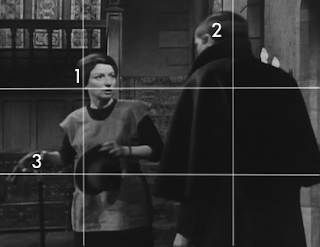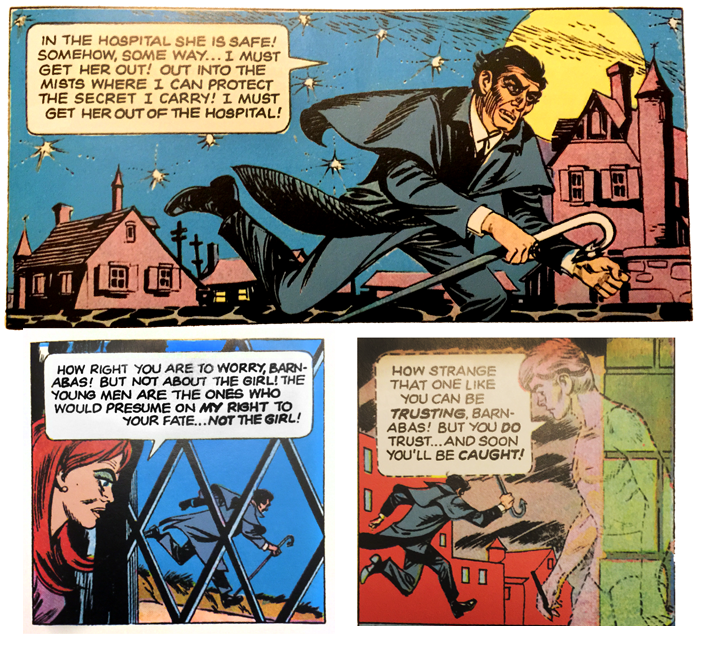By PATRICK McCRAY
No other character on television is quite as iconic... in the same way... as Barnabas Collins. Human in his frailty. Mythic in the fate he will chart. At the very least, he was a figure designed to save a network television show and potentially the careers of everyone involved. April 14, 1967 was the most important day in a lot of lives, most specifically the life of
Dan Curtis. He had already introduced the reality of the character prior, with the image of the hand from the chained coffin. When I first saw that shot, it felt like it had always been in my memory, even though I’d never seen it before. It’s simple, fierce, savage, and sudden.
How do you top that? Because we have to see all of him at some point. Director
John Sedwick’s approach sustained the iconic resonance of the shot of Willie’s strangulation. Can’t top it for blood and thunder without sliding into parody or the unproducible. Barnabas is about dichotomy. We’ve seen the beast. But what else is Barnabas? What makes us want to solve him? Take his hand as a friend? Share in his secret?
Episode 211. Shot on April 14, 1967.
His introduction happens in just three images. In them, there is a knock at the door of Collinwood. When Mrs. Johnson answers, she encounters a man -- whose face we do not initially see -- introducing himself as a visiting cousin from England. He’s seeking the woman of the house. Mrs. Johnson, startled by something about him, shows the man in. They exchange pleasantries, and as she leaves, we finally see him next to the 1795 portrait of Barnabas Collins. The man is a twin for the painting’s subject. And his name? Also Barnabas Collins.
Two clear and subtly clever images with a bridge. His introduction comes from his own perspective, rather than Mrs. Johnson’s. It’s an exterior shot of the entrance, looking in.

The grid helps us divide the image. People in the west read from left to right, and tend to circle in our gaze back to the left. Sedwick uses this model of composition in all three shots. In image 1, we see someone -- him? -- through the eyes of Mrs. Johnson as the camera hangs over his shoulder, minimizing her (1.1). Why is she so transfixed? We follow her gaze up to the towering figure (1.2). Following the slope of his collar, we come back to Mrs. Johnson… specifically, her throat (1.3). After that, we circle back up to her gaze, even more worried. For what reason?

Then he enters with purpose, and we next see him again from the back, divesting himself of his cane and hat, getting a glimpse of his strangely antique cloak. His voice is rich with a uniquely tentative sense of authority. We still don’t see his face, just bits of his profile. These moments tease us, and yet they put us in the position of a confidant of the vampire’s. The composition mirrors what we saw outside. Within, Mrs. Johnson (2.1) is minimized, and the turn in the figure shows him looming, ready to pounce. Again, we begin with her, following her gaze from left to right. The mystery of what bedevils her, bedevils us, as well. The man towers (2.2) in the right, blocking the exit. Instead of following a sloping collar, we follow its larger, expanding offspring in the cape, which takes us circling to the left again where we stop on the poor, miniscule shield of his hat and then, like a wolf pulling her away, his feral looking cane (2.3).

Situated so close to the predator, with his gaze elsewhere, we have a strange safety. We don’t see him from the eyes of his prey. Instead, we are a quietly unacknowledged friend. Finally, as Mrs. Johnson goes to summon Elizabeth, the figure turns to face the portrait, rotating upstage to let us see him from profile to profile. As she exits, and we are alone with him, the chiseled face comes into focus from the side. It is alien. It is familiar. We think we know why, but then we see why. They are only face to face for a moment before the camera takes us away from him and uncomfortably close to the painting from 1795, cold and haughty and haggard and sad. He then steps even uncomfortably closer to it and spins to give his inevitable name. We see the two men in mutual relief.
The painting of Barnabas is a prisoner in a four-sided frame on the wall, disapproving and distant as the first thing our eyes rest on (3.1). Is the painting gazing at the man? No. The more we look, the more the painting is gazing at us, as if we’ve been caught looking. It’s natural to avert our eyes from this, and by comparison, section 3.2 is practically benevolent. His impossible doppelganger is standing before it in three dimensions on our 2D screen. Liberated, he smiles, and there is something optimistic about it. He’s gazing upward to the landing, yes, but it’s also to the future. Gazing left, he’s anticipating the next image rather than look for one that has passed. Subtly, our eyes wander down to 3.3, his medal, a subtle reminder that, despite his strange warmth, he’s a soldier as well, and a force to be reckoned with.







































